InfoMagic and the Linux Developer's Resource CD Set
10 Jun 2023 - faintshadows
A friend had sent me over some Linux floppies and CDs when sending over his old HTC Vive for my partner to use (thanks again, dog!), and alongside the BeOS boot floppies (!!), was a 6 CD set, titled the Linux Developer’s Resource.
The contents of this CD set are as follows:
- CD 1: RedHat 6.0 (Installer)
- CD 2: RedHat 6.0 (Source RPMs)
- CD 3: Caldera OpenLinux 2.2
- CD 4: SuSE 6.1
- CD 5: Slackware 4.0 (Installer)
- CD 6: Slackware 4.0 (Sources) + WordPerfect for Linux + Kernel 2.x Source Archives
That’s a whole lot! What seems to be the entirety of Red Hat 6.0 and Slackware 4, and just installation media for Caldera and SuSE. To me at least, RedHat and Slack are old news, I’ve used them both a fair bit on old machines, and I know what to expect. Caldera and SuSE however… I’ve never even heard of Caldera OpenLinux before getting this CD, let alone used it at all. And I’ve never touched an old SuSE, just the new Leap and Tumbleweed distros. Caldera claims it includes “…unique features, making OpenLinux the most reliable and easy-to-use Linux available.” But who didn’t claim that.
We’ll be checking out OpenLinux later, or attempting to. I’ll be installing it on the Dell Precision 220 I mentioned in my last blog post.
But what was InfoMagic? Looking that up online just reveals junkware, nothing about this former company. Looking up “InfoMagic CDs” narrows it down a bit, but only to Internet Archive links to already archived CDs, or listings for them. Their site is long gone, and I’m having to piece together what I can from their archived sites on the Wayback Machine.
I’m no historian, but from what I can tell, InfoMagic was a company based out of Flagstaff, Arizona, that did a fair amount of computer related things. Namely CD distribution, but also some “Internet Services”, which seem to be hosting websites with virtual hosts, technical support, and ran a CyberCafe at the local Bookman’s, a large book retailer in Arizona. They even went to trade shows, like Comdex and… DragonCon. I’m serious, their website from ‘97 says they were going to DragonCon in Atlanta that year. Checking the DragonCon site doesn’t seem to mention InfoMagic at all, so I have no idea what they would’ve been doing there, I hope they had fun though, it looked like a killer convention.
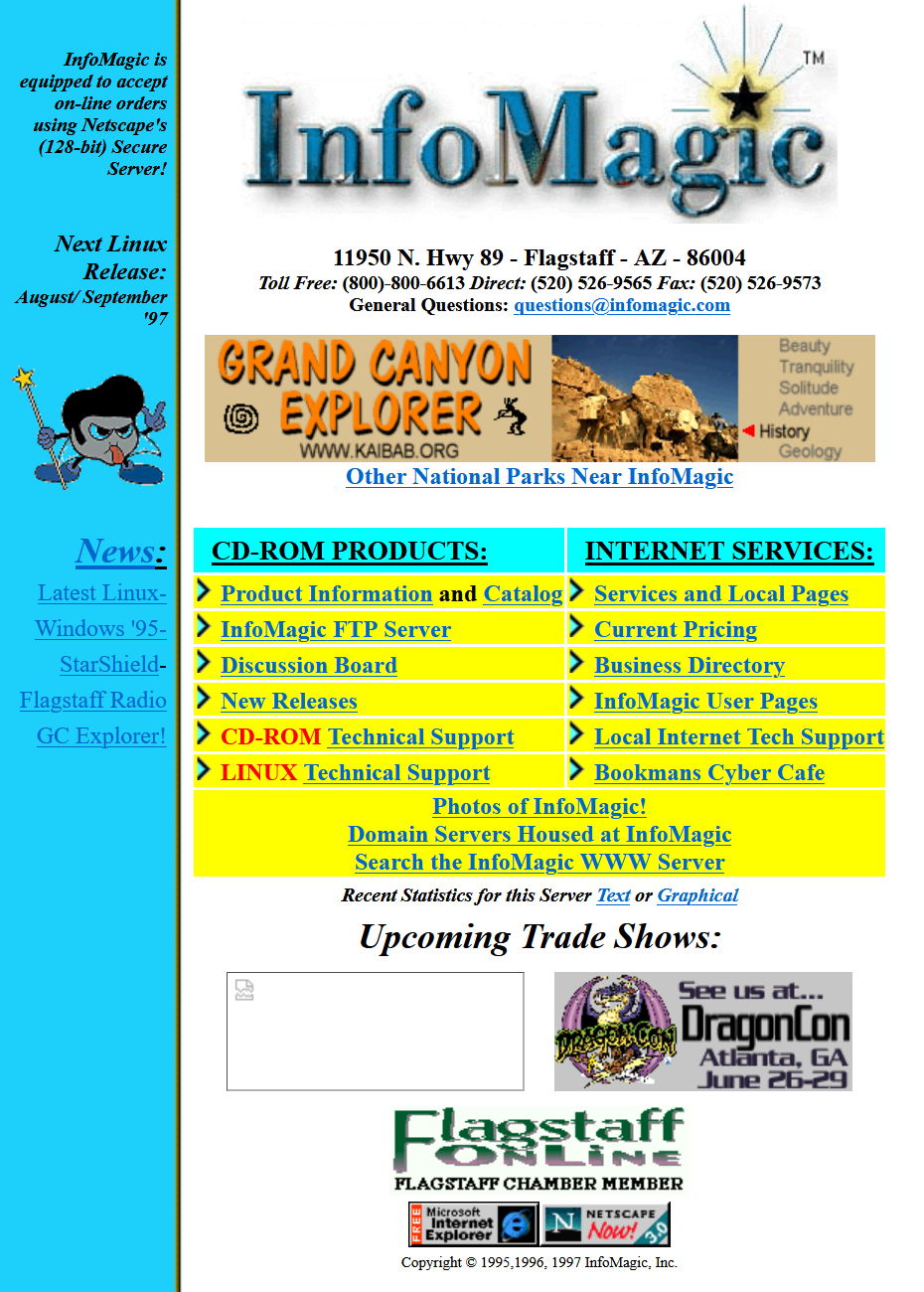
The CyberCafe actually sounded like a sweet gig, they had people there to help you learn about the Internet with a fleet of Pentium-166’s with Win95 and a blisteringly fast ISDN connection (provided by InfoMagic). You could learn how to make your own websites with Microsoft FrontPage, use the ISDN link to download files, surf the WWW, read Usenet, connect to “Internet Relay Chat”, and send E-Mails. I genuinely would have loved to go to this, it sounds like a great time.
Other services were a Dial-Up ISP, 20 bucks a month got you unlimited use, with no distinction between personal or business, that rocks. You also got a tilde page (eg. http://www.infomagic.com/~faint), and 5 megs to fill up with your best HTML and GIFs. If you wanted a “real” website, you could get a virtual domain for 50 bucks, plus 30 a month, and your choice of a SunOS or Windows NT server. They even offered, for 15 bucks extra, Secure WWW. You could even run your own RealAudio stream! 20 bucks a stream per month, pretty ballin’.
Unfortunately, past the ‘97 copy of the website, they rapidly adopted newer Web technologies, so they’re not archived very well on the Wayback Machine, so most of the info I can find was all from back then. And it doesn’t look like they lasted long past the dot-com bubble.

In May 2001 the site became a placeholder page for an “EBIZ Enterprises Incorporated.” The sites linked there were the EBIZ site, which was very corporate, the first link to load for me was “Sign Up as an EBIZ Shareholder,” gross. The other was LinuxMall.com, which seems like everything InfoMagic did but less repacks and more official media, and a lot of hardware. Like a Cobalt RAQ 3i for $2,349. What a deal.
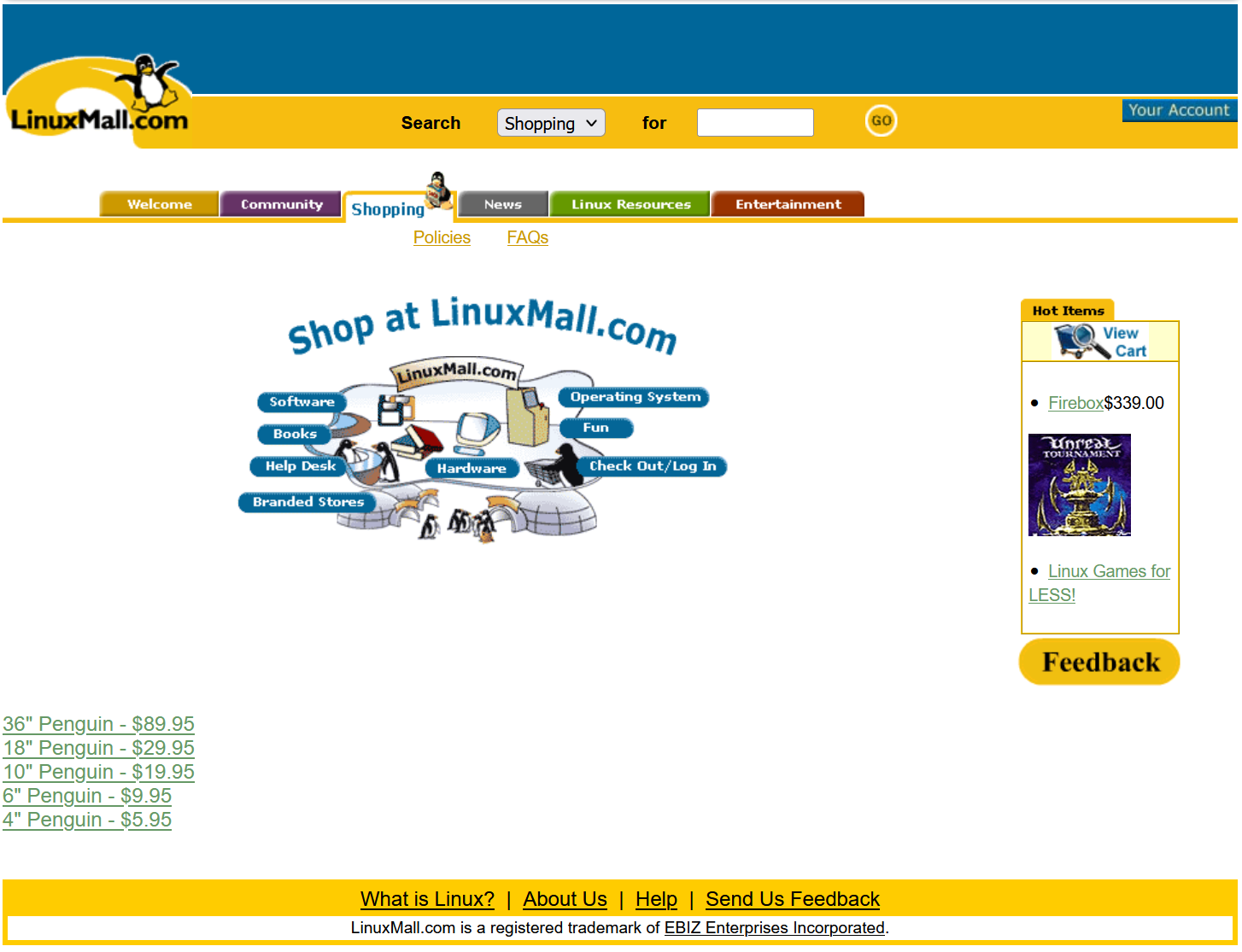

Cute UI though, and oh my god, Tux boxers, incredible, I’ll take 10.
That’s enough about what happened to InfoMagic, let’s go back, and check out the 1996 CD catalog. One can see just how much stuff they were selling. Thirty-four products in 1996, and my CDs are from ‘99! Who knows how much they were selling at that point.
Of particular note in that ‘96 catalog, are a few things. There’s the InfoMagic Workgroup Server, which claims to be “the first Linux distribution designed specifically for servers.” Their words, not mine. Citation needed and all that. 1996 though, so I could believe it. There’s “normal” CD-ROMs, edutainment style informational CDs, about national parks, or historical texts, and shareware compilations. Also included in there is a CD chock full of CCITT/ITU standards, along with every RFC. Neat stuff. There’s a few books, some t-shirts (I want some so bad), and even a magazine subscription!
Also in the catalog are FreeBSD and NetBSD discs, some website archives, quite a few programming CDs, containing sample code, sometimes with compiled binaries, compilers, and other related tools (typically shareware). The appropriately titled “Source Code CDROM” contains some interesting source archives, like the MACH kernel, uncompressed 4.4 BSD code, and this new fangled “Portable Network Graphics” source, marketed as a replacement for the everpresent GIF.
Not in the catalog but also on IA when I searched for InfoMagic, was what looked to me like a CD archive of Usenet. Like, the whole thing. At least at first glance it sure seemed that way. That’s absolutely wild to me, but I guess I shouldn’t be surprised, text compresses really well.
I’d love to get a hold of more of these CDs if I can, they look like an absolute treat to dig through. And archive if they aren’t already, there’s some important stuff on some of these!
It also seems that the CD I have in my book Linux Unleashed: Second Edition by SAMS Publishing is also provided by InfoMagic. Small world!
The CD we’re talking about today though, I found the listing on InfoMagic’s site, and you could get this 6 CD set for $27.50 + $5 domestic shipping ($12.50 for international). Not bad! Part of that money went to the Free Software Foundation, XFree86, the Linux Documentation Project, and the Linux Grant Program. That’s awesome, you love to see that. They even offered a subscription service, where you’d get the yearly CD for a reduced price.
Alongside the aforementioned distros and software, the site claims there’s a copy of Apache, XFree86 (I sure hope so), and Netscape Communicator 4.6, as well as a complete copy of the Linux Documentation Project. Really packed these CDs to the brim with just about anything you could ever need to get going with Linux. With the 1998 release, they separated out the collection to two sets, the set with all the distributions, and an Archives set.. The Archives hold an equal amount of CDs worth of FTP archives, 1999’s release had:
- Sunsite (sunsite.unc.edu)
- GNU (prep.ai.mit.edu)
- The Kernel (ftp.kernel.org)
- KDE (ftp.kde.org)
- XFree86 + contrib (ftp.xfree86.org)
- LessTif (ftp.lesstif.org)
- GNOME (ftp.gnome.org)
Needless to say, I want it. I imagine all of these sites have been archived already, but having a physical snapshot of them would be sweet.
But I don’t have that, so let’s dig into what I do have. And we’ll start with the Caldera CD.
I put the CD in the Dell and booted it, and it hung partway through when probing SCSI devices. Great. So I booted into Windows 98, which was still installed on here, and loaded the Getting Started Guide off the CD. It looks like I can pass install er=cautious to the boot prompt and that should let me boot into the installer. While I was in there, I skimmed the rest of the install process and it looks dead simple. They even let you play Tetris while the install finishes if you complete your initial user configuration before its done. Very Ubuntu like, where you do initial user configuration while it goes ahead and installs. They were really going for it with this, when the installer boots it plays a full screen animation welcoming you to the system. Good stuff. Except I saw my Ethernet card wasn’t detected, that sucks. Moving on though, I don’t need that right away, not like I’d be able to do much.
There’s a lot of autoconfiguration going on with this installer, and that’s great. Having used earlier Linux distros, not knowing exactly what I have in this system and having to trial and error it sucks! I find it interesting how it auto-detects what type of mouse you have when you first move it, there’s a noticable hitch when you first touch the mouse in the installer. Something of specific note, it defaults to a 3 button mouse, but lets you pick from a list of mice for different button layouts. I selected IntelliMouse, since this Dell mouse is just a rebadged Logitech, as was the style of the time.
As I don’t care about the Windows 98 install on here, I told the installer to use the entire disk. I think this may have been a mistake, as this is an 80GB IDE drive. It’s taking its sweet sweet time to “prepare” the disk. Checking TTY1, it looks like it wrote out 3 partitions and is sitting on Re-reading the partition table... I have no idea what this process even entails, but the hard drive activity light is solidly on, maybe it’s re-reading the whole disk? The system isn’t frozen, the mouse is still responding fine, I think it’s just stuck waiting on I/O.
After about 8 minutes of nothing, it figured itself out and I can continue. I am now presented with 4 install options:
- Only the minimum set
- All recommended packages
- Recommended packages, plus commercial
- All packages
I’m picking the 3rd option, as it includes WordPerfect 8 and StarOffice 5. Including WP8 leads me to beleive the copy on disc 6 of this set is for the other 3 distributions. Kinda wish they shipped StarOffice instead, that would’ve been more useful!
After clicking Next here, the install process starts in the background, and I’m asked to select my keyboard type and layout. Then, the video card. It detected my ATi Rage Xpert128 as an “ATI Unknown Chipset”. Great. I was sure by 1999, Linux would have had support for the Rage 128 cards. Now, I’m given the option to probe using the SuperVGA X Server, and the installer says to if you have a higher-end card. In case the system freezes though, I waited until the package install in the background got to 100%. What I got, however, was a black screen, but the system was still installing, I could hear the CD drive seeking and the drive lights were going off as usual. Strange.
I switched TTYs to see if there was any errors, and when I switched back to the installer, I got X back and a message box “Probing is complete and apparently successful.” However, nothing changed. It’s still listed as an unknown chipset with 256K of video memory. I know that the Xpert128 is a 16MB card, and there’s a new message next to the “Probe” button saying if this information is inaccurate, this version of OpenLinux probably does not support your graphics card. Tragic. I don’t feel like writing down what all the mode clocks are for this card, I can adjust the X server later if I feel like sticking with OpenLinux.
I was then asked to select my monitor type, and it defaulted to a generic profile for 1280x1024. To play it safe, I set it down to 1024x768. There were a ton of monitor listings, the side panel in the installer says over 1,700, and I believe it. The next screen asks what video mode you want to use, and it defaulted to 1152x864 at 89Hz interlaced. I have no idea where it got that from, and that sounds awful. I selected 1024x768 at 60Hz non-interlaced, and when selecting “Test this mode,” I am once again left with a black screen, to no surprise. I switched to TTY1 and back to TTY8, and the installer came back. I tried 640x480 and I also got a black screen. What’s strange is that even this known good mode still doesn’t work, I wonder if something’s making this monitor not want to sync up. I left it at 640x480, hoping that once it’s all over with, I’ll get something.
After that, user setup. Root password as usual, and then I’m asked to set up my own user. The shells you’re given are bash, tcsh, and zsh. Obviously I went with the latter.
As the 3Com network card wasn’t detected, I chose no ethernet when asked, and set my hostname. aurora, if you were wondering. I know, nothing fancy, but it’s what was free on my List Of Hostnames index card. Time zone next, and this installer gives you the option to specify if your hardware clock runs in UTC or local time, something we’re just now getting in modern distributions. After that, the game of Tetris that I don’t get to play because it’s already done.
I clicked “Finish” and I’m brought to what looks like the boot process off the hard drive, but I didn’t go through a full reboot? Did kexec exist in 1999? A quick search says no, an article from IBM’s website from 2004 talks about kexec and that two things predated it, bootimg, and Two Kernel Monte. I’m not going to dive into either, they’re out of the scope of this article.
Back to the Dell, while I was looking that up, it tried to do a filesystem check and failed, and just sat there. TTY1 says to check TTY11. I have never seen a distro use any TTY above like, 7. And the OpenLinux installer used TTY8. Anyways, TTY11 has fsck complaining that there’s illegal blocks on /dev/hda3. I have no idea what parititon /dev/hda3 even is, where it’s mounted. I am assuming /usr. Re-running fsck on that partition, so, so many illegal blocks and inodes that are “in use but have dtime set”. I have no idea what the hell happened here, I’m just holding down “y” and seeing what happens. After holding down “y” for 2 solid minutes, I remembered I could just tell fsck to auto-fix, so I Ctrl+C’d fsck and told it to just send it. I don’t care what’s on here, and if this doesn’t work, I can just install it in a VM off the disc and probably have a better time.
While that runs, let’s speculate together. If I had to guess, 1999 Linux doesn’t really know how to handle an 80GB IDE drive. I don’t know off hand how big enterprise drives were at this point, but I imagine not nearly this large1, and if they were they were SCSI, and the SCSI controller would handle that. My SGI Indigo2 has an 80GB SCSI drive in it and IRIX doesn’t seem to care, so something’s probably weird with Linux’s IDE stack. Or it’s something about the i820 chipset in this machine coming out after this CD was pressed. Maybe there’s some quirk in the IDE controller that was not accounted for because the kernel devs quite literally had no idea this hardware existed.
For some context of time, it has been repairing this partiton for so long that in the meantime, I have gotten up, and made a full breakfast from scratch and it’s still not done. It’s actually taking forever. After fourty minutes, the sceen scrolling stopped.
Filesystem contains large files, but lacks LARGE_FILE in superblock. Fix? y
Restarting e2fsck from beginning...
You’ve gotta be kidding me.
It kept going again, then after a few more minutes, it restarted again. But this time, it gets better.
Corruption found in superblock. (blocks_count=0).
The superblock could not be read or does not describe a correct ext2 filesystem.
Oh, it’s hosed. I think the hard drive in this is toast. To a VM! (Update: I tested the hard drive while writing the rest of this and it checked out fine so I think it was just some weird issue with the drive being massive.)
I can’t recreate this same setup in 86box, so instead I went with something that I think OpenLinux would have actually expected. The specs of the VM are as follows:
- Pentium II (Deschutes) @ 400MHz
- i440BX chipset
- 128MB RAM
- Cirrus Logic GD5434
- PS/2 Mouse
- No sound
- 2GB disk
I picked the GD5434 because that’s what my Pentium 1 box has and it may be trash but I know for a fact XF86 supports it.
After futzing about with a bunch of configurations to actually find one that worked and booted (they would all get stuck at Booting the Kernel), I could finally move on to the installer, which I will not explain again unless it’s doing other wacky stuff.
Which it did! The inital disk setup took a hot second, not nearly as long as last time though. And X11 still didn’t want to work properly! It did properly detect the GD5434 as a video card, but whenever I would test a video mode, it would just throw up some weird partial, repeated image, but only in 256 color mode, in any higher it wouldn’t even try.
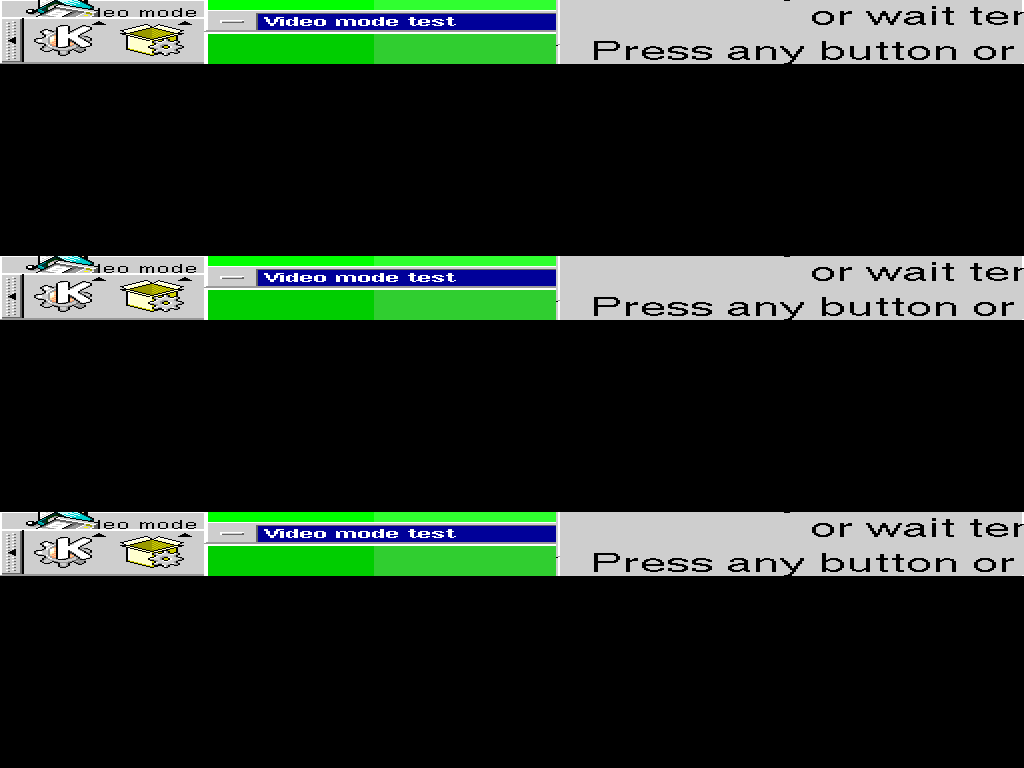
86box defaulted to giving it 4MB of video memory, and maybe that’s too much? I don’t know why it would be an option if it wasn’t. But we’re too far now to change it. Time for the first reboot.
And it succeeded in doing its weird kexec style thing, and got past the filesystem check, but when it got to starting KDE, it went to a blank screen with INIT going to runlevel 3 and sending everything the TERM signal, and hung. After a reboot and booting off the hard drive, same end result. I do have a login prompt though, but the system is still in runlevel 3. And if my sysvinit knowledge is correct, I should be in runlevel 5? But no matter what I do, it goes into runlevel 5, but then drops out to 3 right after. Very strange.
Thinking something was maybe up with the video card, I quickly redid the whole install with an AGP S3 VIRGE in place of the Cirrus Logic. And to my surprise, it liked the S3 much more. Probing the card with the SVGA server successfully reported back with the right settings, and testing 1024x768 worked right away, even at millions of colors. Now, in retrospect, I should have also probed with the SVGA server on the Cirrus, and with any luck, it would’ve been fine if I did that. But oh no! How terrible! I have a better video card in here now.
Will it actually boot afterwards, that is the question.

Yes, yes it does. After what felt like ages, and was about 3 hours, I have a login screen.

I’m greeted with the KDE setup an- oh my god is that a BeOS theme yes please give this to me. Perfection.
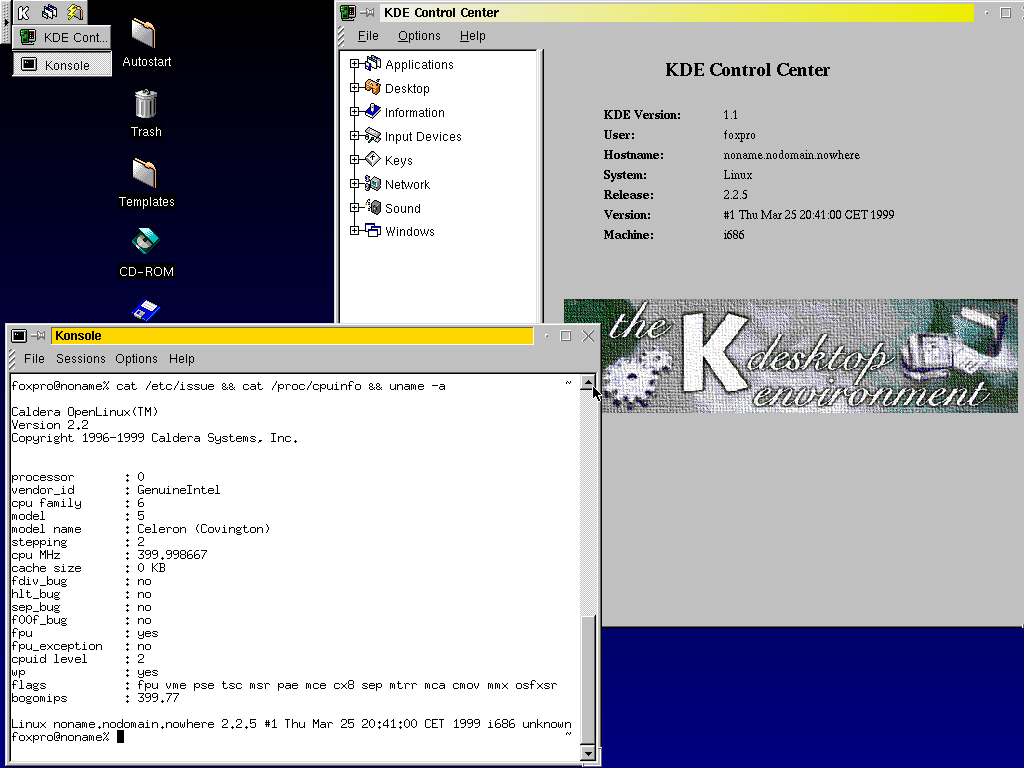
Anyways, here it is, Caldera OpenLinux. Curious if I could get sound working, I added an AWE64 to the VM, and I found a cool kernel configuration utility. It shows you all the available and loaded kernel modules, and you can also get info on them so you know what it is. I added the AWE module, and I even got a prompt that I need to also add the sound module, and I rebooted.


No sound. the Linux meme returns once more. And the CD documentation doesn’t mention sound at all. Oh well.
At this point in writing, I’ve been on this specific project for about 7 hours straight. Besides, now that OpenLinux is installed, and most of the distro-specific stuff is over with, it’s now just Any Linux Circa 1999. It’s not like Slackware where you install everything all at once and you can dig around and figure out what all that stuff you just dumped on your hard drive was. This has a whole lot (though I can’t find StarOffice), but I don’t quite know what to look for yet.
Next though, we’ll look at SuSE 6.1. I am once again trying this on the Dell, just to see. My hopes aren’t high though, so I won’t get into details unless it works.
The SuSE installer is a text-mode installer, compared to Caldera’s offering. It’s definitely built more towards someone who knows what they’re doing, on the first menu you’re able to pick “System Information” and get a bunch of info listings, like /proc/cpuinfo, lspci, and the likes. Doing so showed that the latter has no idea what the video, or network card is. Go figure.
However, like the Caldera installer, creating the partitions moves at a glacial pace. It’s not frozen or anything, I can see the hard drive light flickering. Really thinking I oughta get a smaller hard drive for this machine now.
After about 20 or so minutes, I came back to an OUTPUT OF E2FSCK window, claiming the filesystem (that it just created) was not cleanly unmounted, and it’s finding Duplicate/bad block(s) in the inodes. Yes, this is that same 80GB hard drive, but while I was installing Caldera in a VM, I did two tests of the full disk and they both came back clean! So it goes back to my original idea where the drive is just purely too big. Back to the VM.
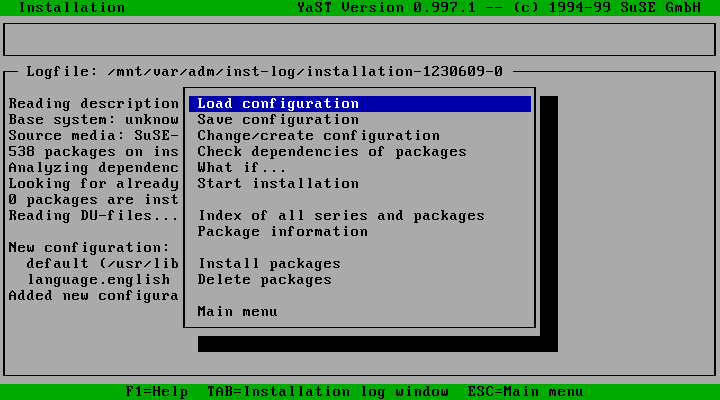
Once it got past the partitioning part, I was dropped into YaST. It’s super clear how different the experience would have been compared to Caldera, which used a almost Windows-like install process. Having the install manual handy for SuSE would be pretty nice about now.
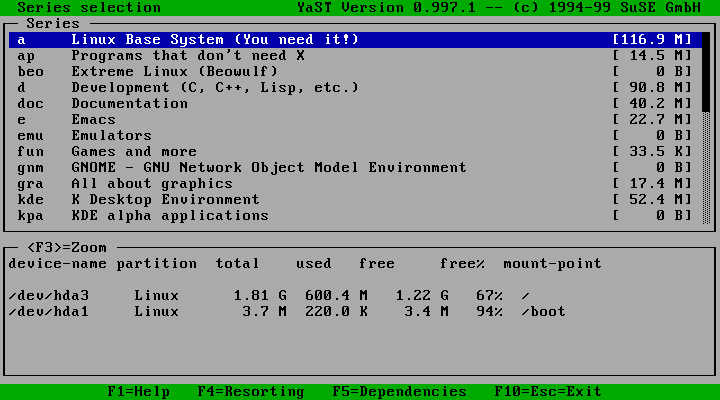
I selected create configuration, and I was dumped into a package series listing very reminiscent of Slackware. Which checks out, SuSE was originally a German translation of Slackware (Which I did not know until just now).
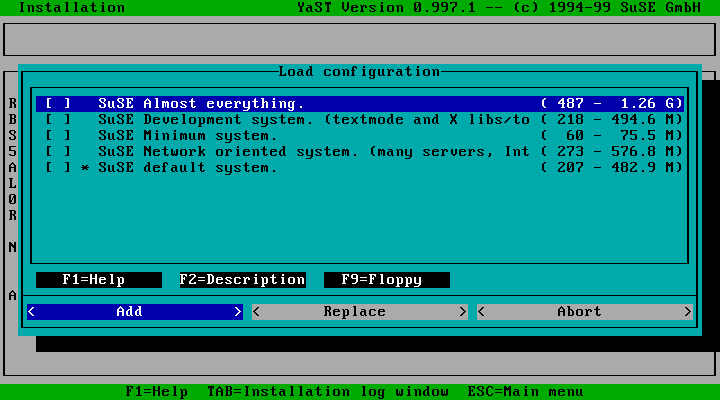
By the looks of it, there’s already a default package selection set. And if I backed out and hit “Load Configuration,” sure enough the “SuSE default system” is set. Was I told there would have already been configurations made? Nope! It’s probably in the manual, but if I only had the one computer back in ‘99 I wouldn’t have been able to read the docs off the CD I was installing from. I would have had to prepare this beforehand, and either read the docs and take notes, or print it out.
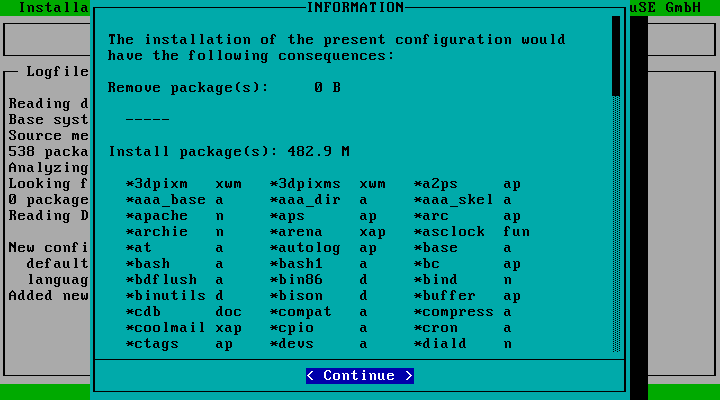
I wanted the default configuration anyways, so before I poked around what other options there were, and the “What If…” option had some fun wording: “The installation of the present configuration would have the following consequences.” How official sounding.
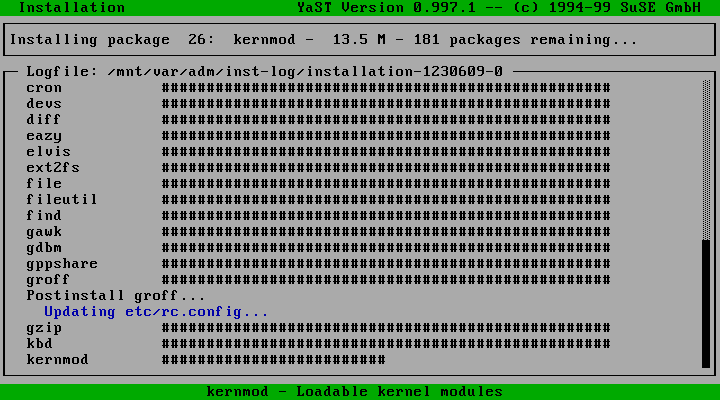
I select “Start installation” and off it went, and the Slackware similarities continue. As it installed each package, the bottom of the window explained what the package was that was currently being extracted. Better than Slackware though, is that it actually shows progress for both the current package and overall.
Once it’s complete, I’m brought back to the menu at the start, and I guess selecting “Main menu” was the way to go because that brought me to the kernel selection. Something present there that I wasn’t aware was even a thing was a kernel that supported IBM’s Microchannel systems. To the best of my knowledge, it was always an unsupported system.
After selecting the “(E)IDE Kernel”, I was asked to create a book disk (no) and the configure LILO. I don’t think I’ve ever had to create a config for it from the get go, I thought the installers always took care of that, even Slackware’s does if I remember correctly! Fumbling through that, I made what looked like a good setup. Time zone information follows, again asking if the system clock was UTC or local time (I swear I never saw this option when I was using Linux in the 2010’s). Username aurora again, and this time I had to specify a domain name, so I tossed .local in there to make it happy. It asked if I wanted to set up TCP/IP in loopback mode or real network mode. Like before, I don’t care for networking, so we move on. I was then asked to set up sendmail, which they conveniently had an option for a single user machine with no network. SuSEconfig was launched, and wrote all my changes to disk.
Like Caldera, SuSE also used a kexec style method to just hand it over to the hard drive and I was asked to set a root password, 8 character max. YaST starts again, and I’m asked to set up my user, a modem, my mouse, and it committed all those changes. After that, it switches runlevels to then start the rest of the services and go multiuser.
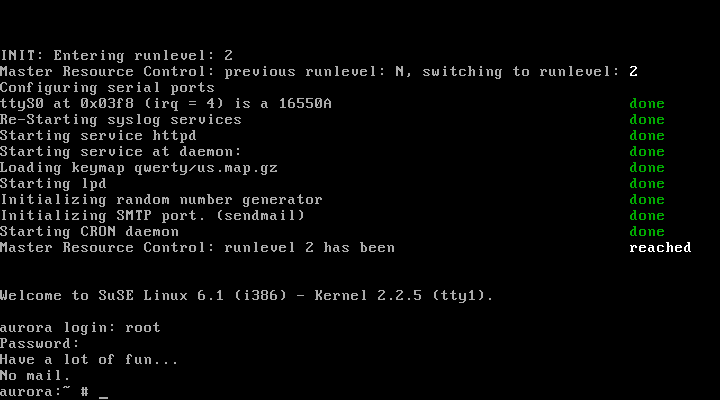
I’m left with a login prompt, and that’s it. No X11, just a TTY. Curious if X11 was even set up, I never was asked about it, I rebooted. YaST restarted again, and said there were two documentation packages that weren’t able to be installed. I mounted the CD and said to install them, but they failed, saying they couldn’t be found. Interesting, but alright. I continued and saw XFree86 not configured yet! No graphical login. Check /etc/XF86Config.
Oh no, not again. Worse, it’s an empty file. I actually have to dive into the documentation for this one. On the CD there’s a 1.7MB text file called BOOK.TXT and it’s what it says on the tin, the SuSE installation book. Word for word, they didn’t even format it for a plain text file. Chapter 9 is on the X Window System, found at page 199. Given this is not a book, that equates to about line number 14,196, for those playing along at home. There is a tool specifically made for SuSE called SaX, the SuSE Advanced X Configuration Tool. They left off a few letters, I guess SaXCT doesn’t sound as nice.
I launched the utility, and was presented with some great early 3D graphics that I could not get a screenshot of fast enough, and I was asked to set up my mouse. I made the mistake of setting it to an IntelliMouse, as this forced the cursor into the top right corner and I couldn’t pull it away, it kept going back. SaX asked if I wanted to disable the mouse in case it didn’t work, I did, and then I lost all input, and had to force restart. Turns out you don’t have to set the mouse type to proceed, but the UX sure makes it seem like you need to.
While I restarted, I checked over the docs again and they said to check if your specific X Server for your card is installed, else it’ll use the standard SVGA one. Curious if there was a S3 VIRGE specific server, and sure enough, xs3v is the one to use. I installed that, and SuSEconfig is invoked again to take care of the post-install processes.
With the new X Server installed, I run SaX with the -s XF86_S3V option to use the special VIRGE server. The card was autodetected, and I selected a 1024x768 LCD from the “!!! LCD !!!” section.

I set 16 bit color, and strangely, when testing the X Server, it loaded, but with two desktops side by side? Like it was 2048x768, very strange. Changing it to 24 bit color fixed it. Saving that, I was now ready to start X as my user.
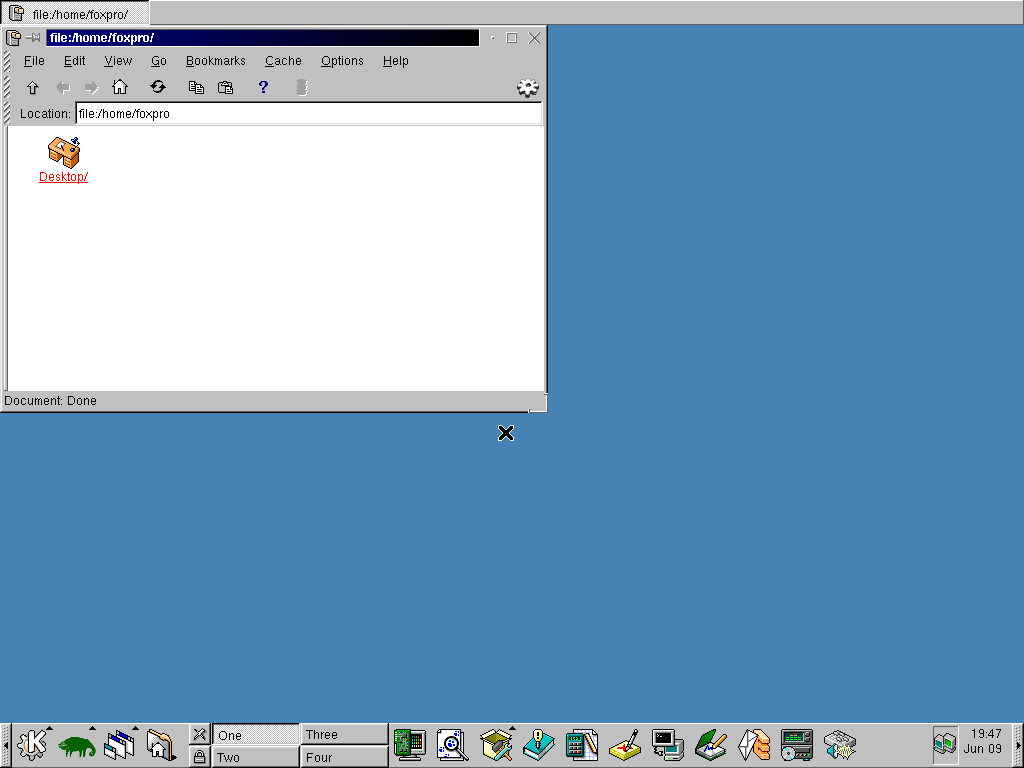
The all familiar KDE. I won’t stay on this for long since it’s the exact same version as Caldera, just without the cool BeOS theme :(
Since there’s not much else interesting going on, and I have actual documentation this time around, how hard would it be to get sound working? Can I redeem 1999 Linux from its flaws and play a sound file?
The docs have a section on sound, and they say that OSS supports almost all ISA sound cards, of which the AWE64 I have in here is one of them. However, the documentation says the OSS package is under series pay. I opened YaST to install it, and it wasn’t there, nor was it in the snd series. Using kfind to search the CD for it, there was no OSS packages on the disc. Searching the CD on my desktop as well turned up nothing. I’ve been played twice! First there’s no documentation telling me how to set it up, and now I’ve been lied to! Right to my face! 4front wasn’t there either, another sound server from the time, also mentioned in the documentation.
All hope is not lost… Yet. There’s a third option, to load the kernel modules directly. they should, if the documentation is to be believed, be already installed. I tried to set up the AWE64 but the kernel docs only mentioned an AWE32 and there was some weird stuff I had to do regarding /etc/isapnp.conf which has a hell of file to parse. Here’s the configuration line for an AWE32 directly copied from the kernel documentation:
(CONFIGURE CTL0044/1132685 (LD 0 (INT 0 (IRQ 5 (MODE +E))) (DMA 0 (CHANNEL 1)) (DMA 1 (CHANNEL 5)) (IO 0 (BASE 0x220)) (IO 1 (BASE 0x330)) (IO 2 (BASE 0x388)) (ACT Y)))
This is truncated, by the way. No wonder nobody had sound.
The SuSE documentation has an example line for a Sound Blaster 16, so I tried changing the card in 86box to one, and I mistakingly picked a SB16 PnP, and that caused the IDE controller to stop working. Even in emulation, it’s Plug-‘n-Pray. Setting it to a non-PnP card, I was able to boot. However doing the command listed in the docs I get… Nothing. They said I should see it in lsmod, yet nothing loads. No errors, no feedback at all, just, nope! Nothing happened.
This is about what I expected, though I would have hoped by 1999 this would have been figured out. This is the same issue I had with Slackware 3.0 from 1995. I blamed it on not having a “real” Sound Blaster. I have a Yamaha Audican 32, which from what I can tell only worked in DOS, Windows, and OS/2. I also had an ESS 1868 or something like it, which was more transparently SB compatible, but neither wanted to work at all. Even on later Linux distros from this same period, like Red Hat 6. I’d just get nothing. Now, something could be wrong with the emulated hardware and the drivers are just incredibly picky about it, but I find it weird that the Linux drivers won’t work, but Windows and DOS would pick it up fine. Maybe there’s more to it than I know about, maybe audio on Linux until like, 2010, was just like this.
This is about where I think I’ll end it for now with the distribution tests, I don’t really know what to do with them once they’re installed. Much like nearly every other vintage computer I own. If anyone knows anything interesting that I could do with this stuff once it’s running that you think would be a good blog post, feel free to hit me up!
The final disc in this set contains the Slackware 4 Sources, WordPerfect 8, and Kernel source collection. On that CD, there’s an infomagic directory, and the readme there explains what all is part of this collection, and the basic install information for the four distributions. WordPerfect 8 seems to just be a 90 day trial version, typical. The kernel sources included are 2.0, 2.2, and 2.3. The final versions are 2.0.36, 2.2.9, and 2.3.3, respectively. From what I can tell, 2.0.36 was released November 1998, 2.2.9 came out May 1999, and 2.3.3 was also May 1999. This tracks for mirror freeze the readme shows, which was June 3rd.
Another feature as part of the set was a locate database file, which would tell you where any file is located across all 6 of the discs, pretty handy actually. …Maybe I could find another OSS RPM from one of the other discs for Caldera or SuSE.
Also included in the infomagic folder is a text catalog, which we’ll get to next, a readme about large hard disks with more than 1024 cylinders, and a hardware compatibility guide for the kernel as of July 1998. The HCL is interesting, it mentions a few things I didn’t even know existed, like proprietary/commercial X Servers that had more support and sometimes better performance. Now that I’ve seen it, it makes sense. Also apparently there was a line of hard drives from NEC that were not fully SCSI compliant and they reported their sector sizes are zero, oof.
The InfoMagic catalog was actually smaller in 1999 than I had expected it would be, only 17 products, though given what I learned about their history, perhaps they were in a downturn at this point. The usual staples are there, this CD set and its counterpart, the Archive CD, the infotainment makes a return, as does the InfoMagic Workgroup Server, and the Standards CD. Nothing new came out, just updated versions of what was already there. Consistency is key, I guess.
Last thing of note on the 6th CD was a folder called RedHatUpdates, and there’s no mention of it anywhere on the included docs. Given the date is about 12 days newer than anything else on this CD, I imagine this is a last minute update right before they sent the images out to be pressed. Peeking in the folder it’s mostly kernel updates, 2.2.5-22, a PHP update for Apache, and Netscape 4.6. There’s a few other smaller packages, new boot floppy images, and the sources for those updates. I don’t have any information of how important these were, but given they shoved this in the last disc instead of just updating the RedHat disc, it may have been a big deal.
Well, that’s all I have this time! Perhaps I’ll revisit this CD set again someday, or get more InfoMagic CDs. I’d like to give a more proper “review” of Caldera at some point, no promises though, it’s still late 90’s Linux and there’s not a whole lot going on there.
I hope you enjoyed this post, it’s one of my longest! I put in about 2 days of work, and actually did research on some topics! Woah! I actually did enjoy poking around the Wayback Machine to see what InfoMagic was all about, and if you’re interested, I’d recommend checking out the site yourself, there’s some extra stuff I didn’t go over.
As usual, not everything goes as expected, and a fair amount of this post is me rambling about how bad Linux was for the end user. Also the typical old hardware issues that plague anyone using vintage hardware.
-
During writing, I have been shown a CNN article from early 1999 showing that in the first quarter of ‘99, the new hotness was a 25GB hard drive. The common capacities were around 4-8GB. ↩